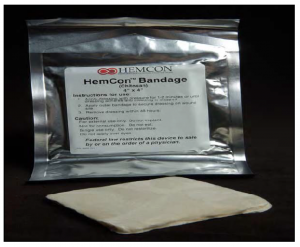During the care under fire phase, the first thing you should look for is significant bleeding.
If you are in doubt of the significance of the bleed, apply a tourniquet immediately and assess it later when you have more time. The body’s natural mechanisms may not be able to control the bleeding. A casualty who is losing blood rapidly may die unless the bleeding is stopped. When severe bleeding is discovered, stop your survey and take measures to control bleeding.
NOTE: This lesson is concerned with controlling bleeding from an extremity. Bleeding from the trunk and from the head is covered in other lessons.
a. External bleeding will be controlled initially with a tourniquet during care under fire. Once the medic has transitioned to the tactical field care phase, the tourniquet will be evaluated for need in the following manner.
(1) If the bleeding seems significant (venous or arterial), then a tourniquet should be applied during the care under fire phase.
(2) The tourniquet can be loosened during the care under fire phase under the following conditions.
(a) Based on the tactical situation. When there is a lull in the battle or the battle has moved away from the casualty collection point.
(b) More time in a safer setting. You have enough time and protection to assess the need for a tourniquet and reapply it if you determine that it is still needed.
(c) More help is available. Additional hands may be needed to assess and reapply the tourniquet.
(3) If you are unable to control bleeding with other methods, retighten the tourniquet. The need to prevent further blood loss is greater than the potential risks associated with tourniquet application.
(4) Some other considerations involving tourniquets are given below.
(a) Can you see what you are doing? Enough light is essential to adequately assess the bleeding.
(b) Does the casualty need fluid resuscitation? If so, do it before the tourniquet is removed. Ensure a positive response is obtained; that is, the casualty has good peripheral pulse and good mentation (mental ability).
(c) DO NOT periodically loosen the tourniquet to get blood to the limb. This is an antiquated technique that will only cause the casualty to lose more blood that can not be replaced on the front lines.
(d) Tourniquets are very painful. It has been documented that patients have tried to remove tourniquets due to the pain they cause. Be prepared to administer narcotic analgesic pain control to casualties to protect them and to provide for their comfort.
(e) If the tourniquet has been on for more than six hours, leave it on. At this point, do not attempt to remove the tourniquet.
b. Once in the tactical field care phase, any bleeding not previously treated should be assessed and treated.
(1) Application of emergency trauma dressings, hemostatic agents, or other means to control simple bleeding may be used at this time.
(2) Hemostatic dressings contain an agent to aid in the clotting process. Currently the Army has approved the HemCon™ Bandage (figure 2-7) for use on the battlefield. Other agents are in existence, but are not currently approved by the Army. The HemCon dressing contains an agent that is non-allergenic and is readily absorbed by the body during the healing process. This agent speeds the clotting process when it is applied directly to the wound. This dressing is advised for bleeding that can not be controlled by tourniquets or other direct pressure, such as high femoral bleeding or truncal bleeding.

